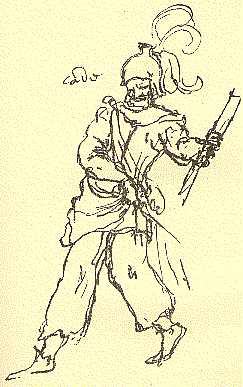The antimasque
Partly because the antimasque often involved grotesque costumes, the parts were played by professionals. The dignified main masque was performed by members of the Court.
In The Tempest, Stephano, Trinculo, and Caliban perform a function similar to the antimasque.
Footnotes
-
The antimasque in Oberon
-CD-->
[Video clip available on CD ROM only.]
Silenus, son of the god of wine, Bacchus, gathers with a group of goat-like satyrs before the palace of Oberon, King of Fairies. After "an antic dance, full of gesture and swift motion," Silenus, far from being a force of disruption, announces that the satyrs must be silent and decorous, because of the dignity of the monarch (James):" . . . For this indeed is he,
My boys, whom you must quake at, when you see.
He is above your reach; . . .
He is a god, o'er kings; yet stoops he then
Nearest a man, when he doth govern men. . . .
'Tis he that stays the time from turning old,
And keeps the age up in a head of gold.
That in his own true circle still doth run,
And holds his course as certain as the sun.
He makes it ever day, and ever Spring
Where he doth shine, and quickens [brings to life] every thing
Like a new Nature: so that true to call
Him by his title is to say--he's all."
Jonson invokes a series of traditional images for the perfection of the king: he is God, like gold, like a circle, like the sun. Click for more on these patterns of correspondence.
